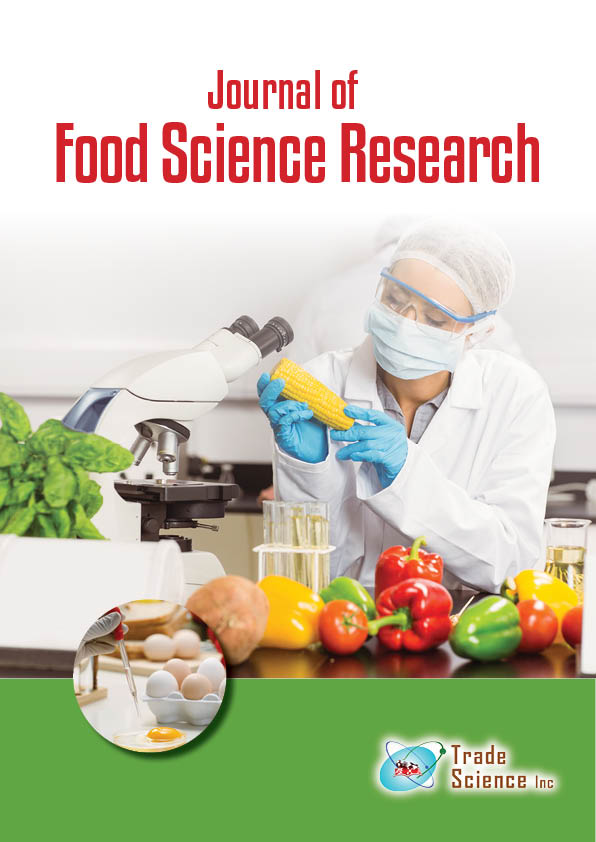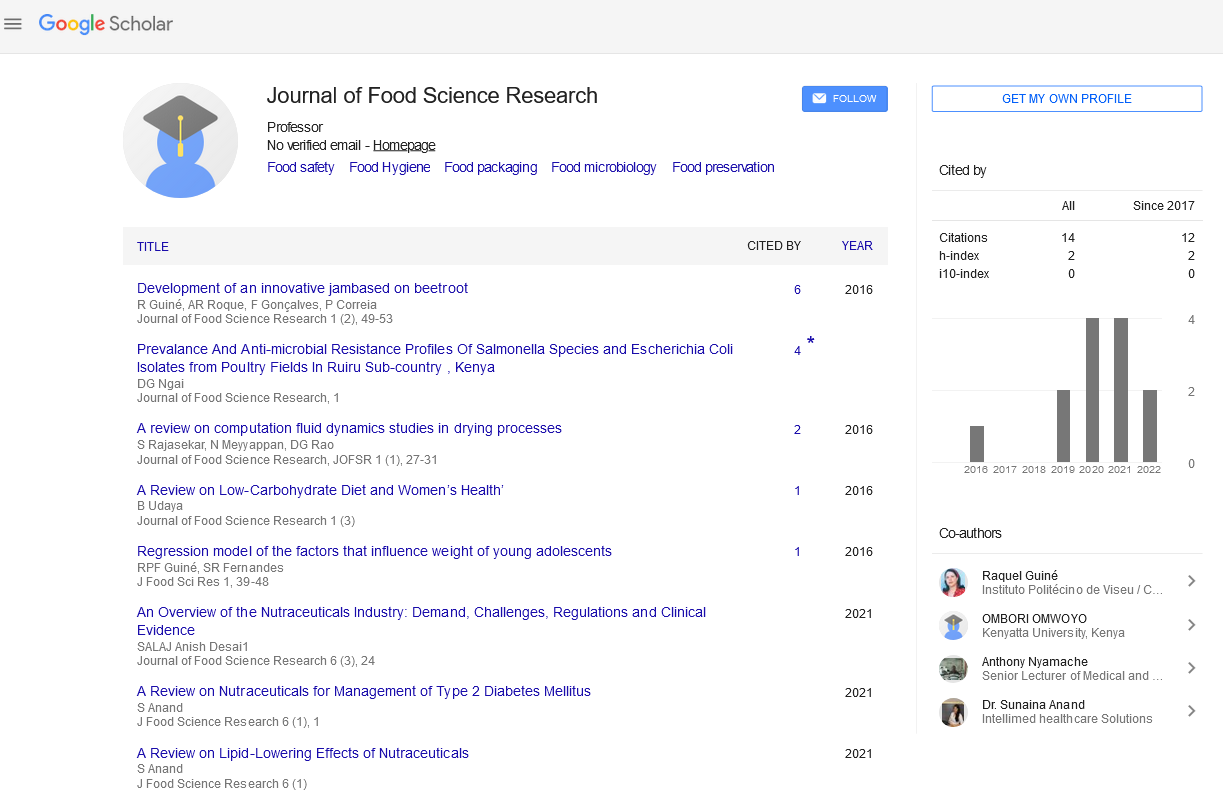Short communication
, Volume: 6( 6)
Food and nutrition challenges and opportunities
The 17 United Nations Sustainable Development Goals (SDGs) provide out a roadmap for current and future generations to achieve long-term global development. SDG-2 focuses on food security and nutrition, with specific goals
of attaining zero hunger, food security, eradicating all types of malnutrition, and supporting sustainable agriculture.
A complementary objective, SDG-12, encourages responsible production and consumption. Our ability to meet these
objectives will necessitate some reflection on current and future food production, global nutrition, and health.
Agriculture?s advancements, particularly biotechnology, have led to significant improvements in food security, nutrition, poverty reduction, employment, and overall development. Total food production has tripled since 1945, and
average caloric availability has increased by 40%. These advancements, known as the Green Revolution, have resulted
in increased food availability as well as substantial public
health benefits, such as a considerable reduction in protein/
calorie malnutrition.
These achievements, however, have come at the expense of agricultural resources and the environment. They have
had a negative influence on water and land resources while also contributing significantly to greenhouse gas (GHG)
emissions. Many public
health issues have worsened, as indicated by major increases in
obesity and accompanying
comorbidities; also, micronutrient deficiency continues to affect a large section of the world?s population. The task
ahead is to start a ?greener green revolution? that improves agricultural production and public
health while also conserving natural resources.
Agriculture, public health, and the environment are all intertwined, and success in all three domains will necessitate a
new paradigm of open, candid, yet collegial, cross-disciplinary debate and interaction that is not simply prescriptive.
It will necessitate the establishment of boundaries as well as the measurement of success and failure. Responsible
production and consumption cannot be judged piecemeal, and in particular, trade-offs between sustainable production
and healthy diets must be assessed. This particular collection?s focus and scope are intended to promote these vital
discussions.
Nutrients, Foods, Diets
Positive agricultural production growth does not guarantee a healthy, long-term diet. The EAT Lancet global health
reference diet, which is described in this collection, makes explicit dietary recommendations. The reference diet, on
the other hand, poses severe problems for general adoption, and the necessary improvements in agricultural production
will be difficult to achieve. The practicality of these production modifications must be evaluated in light of current
national agricultural systems, as well as how and if these tactics will or can be modified to meet agricultural output
targets. The reference diet, for example, would necessitate increase in nut output. It should be mentioned that the planetary
health diet was developed based on nutritional considerations rather than environmental factors.
Agriculture faces tremendous challenges: it will need to supply the food needs of a growing population while using
the same amount of land and employing a shrinking labour force. To keep up with population expansion, agriculture
will be needed to continue to reduce
malnutrition by increasing food availability while also improving food access.
Farm will need to enhance incomes, particularly for the rural poor, be a major driver for job creation, improve
agriculture output, maintain natural resources, and contribute to food security and diets in order to be successful, long-term
agricultural plans.
Corresponding Author: Said Fatouh Hamed, Department of Nutrition, National Research Center, Egypt,
E-mail: saidfatouh@uniba.it
Received date: November 08, 2021; Accepted date: November 22, 2021; Published date: November 30, 2021
www.tsijournals.com
Food Systems
Sustainable food systems are crucial for promoting healthy diets, according to the United Nations. Food systems
encompass all of the elements (environment, people, inputs, processes, infrastructure, institutions) and activities involved in the production, processing, distribution, preparation, and consumption of food; a sustainable food system
extends this definition to include food systems that ensure food security and
nutrition for all while not jeopardising
current and future generations? socioeconomic, environmental, and social bases. ?How
agriculture and food systems
grow over the next 15 years is important to success in achieving the SDGs,? according to an FAO assessment.
International organisations and national governments face a challenge in changing food system trajectories in order to
optimise food security and
nutrition impacts. Given the magnitude of hunger, this will be a monumental job; also, by
2050, food systems will need to feed almost 9 billion people, and livestock demand will rise by 70%, with the majority
of this growth occurring in developing nations.
To address the concerns of sustainability, environmental degradation, persistent poverty, vulnerability, hunger, and
malnutrition, a holistic strategy is required. The potential to respond, on the other hand, are vast, and a fresh, communal, and integrated approach is required. Food systems must become more efficient and inclusive, with policies and
legal frameworks addressing income inequality, supporting livelihoods, and ensuring resilience, all while assuring
coherence and effectiveness at the national and international levels.
Food system theory is well documented, and illustrative conceptual frameworks for these theories have recently been
published; nonetheless, there are few examples of where the complete food system?s impacts have been evaluated.
Many food system factors point to a variety of good and negative consequences across the production to consumption
chain. Decomposing these consequences into the four domains and basic pillars of health, economics, environment,
and society is one way to assess them.
Within environmental and societal standards, the issue for sustainable diets is to strike a balance between dietary
requirements, prices, and cultural acceptance. The papers in this series emphasise how the cost of food is frequently
a limiting factor in obtaining a nutritious diet. Nutrient-dense foods are more expensive; nutrient-deficient foods and
diets, on the other hand, are less expensive and thus more likely to be consumed.
Discussion
The problems for meeting SDG-2 and SDG-12 targets have been discussed in earlier sections; nonetheless, it is obvious
that these challenges are interrelated and cannot be solved separately. Policies that address priority will be required, but
the current governance
model assigns
malnutrition to the
health sector and food insecurity to agriculture, resulting in
a disjointed and incoherent framework that may act in opposition to one another. Consumers, producers, and policymakers all have to make decisions. An integrated framework will be required to overcome these issues, guide policy,
and build a system that supports optimal health, environmental and economic sustainability, and consumer choice
Abstract
The 17 United Nations Sustainable Development Goals (SDGs) provide out a roadmap for current and future generations to achieve long-term global development. SDG-2 focuses on food security and nutrition, with specific goals
of attaining zero hunger, food security, eradicating all types of malnutrition, and supporting sustainable agriculture.
A complementary objective, SDG-12, encourages responsible production and consumption. Our ability to meet these
objectives will necessitate some reflection on current and future food production, global nutrition, and health.
Agricultureâ??s advancements, particularly biotechnology, have led to significant improvements in food security, nutrition, poverty reduction, employment, and overall development. Total food production has tripled since 1945, and
average caloric availability has increased by 40%. These advancements, known as the Green Revolution, have resulted
in increased food availability as well as substantial public
health benefits, such as a considerable reduction in protein/
calorie malnutrition.
These achievements, however, have come at the expense of agricultural resources and the environment. They have
had a negative influence on water and land resources while also contributing significantly to greenhouse gas (GHG)
emissions. Many public
health issues have worsened, as indicated by major increases in
obesity and accompanying
comorbidities; also, micronutrient deficiency continues to affect a large section of the worldâ??s population. The task
ahead is to start a â??greener green revolutionâ? that improves agricultural production and public
health while also conserving natural resources.

